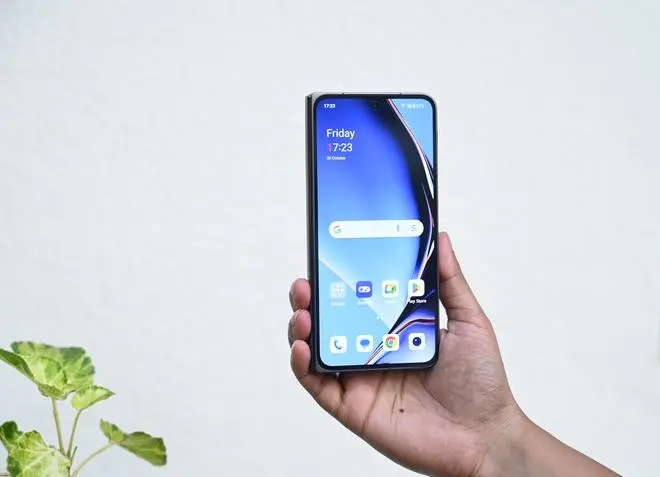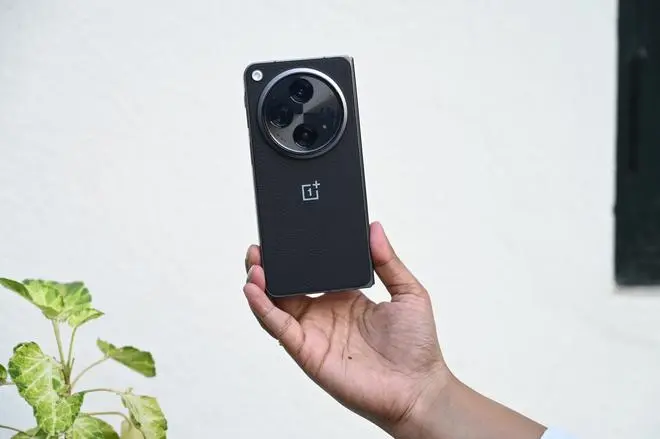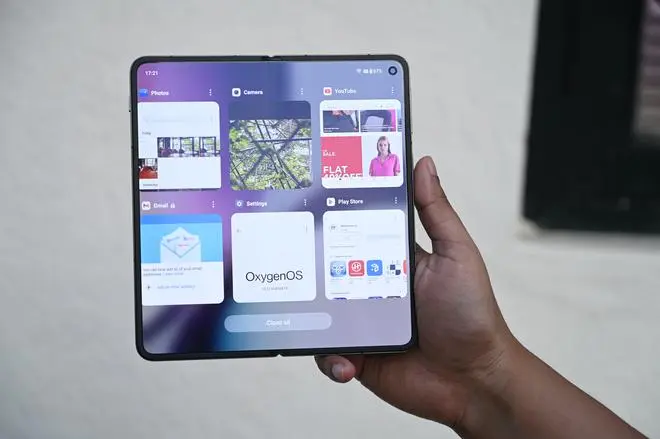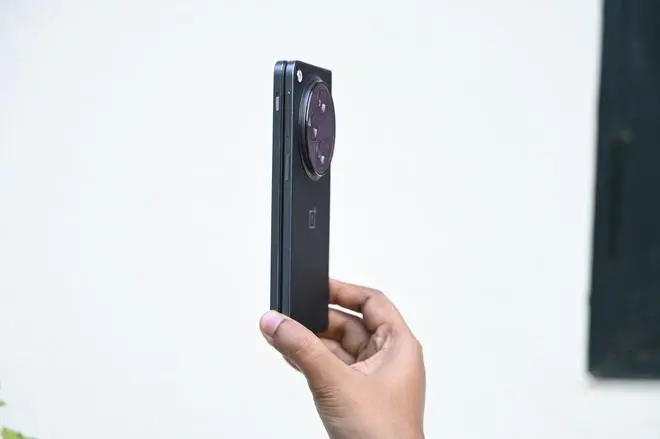I’m sitting in a rustic wooden cabin in the Andamans, with the rain hammering down on the roof. A big, red box in my hands is the reason I’m here. OnePlus has thrown its hat in the ring of making snazzy foldables, and I’m here to take it on a spin around the beautiful islands to see how it fares.
Design

The first thing I notice about the OnePlus Open is how well-balanced its dimensions are, while still folded. The cover screen is not as uncomfortably narrow as the one on the Samsung Galaxy Z Fold5 — the last flagship foldable I used. In fact, the 6.31-inch 2K cover screen is just a smidge narrower than the Google Pixel 7 Pro that has been my primary phone over the last year. As a result, typing out messages and responding to mails directly from the cover screen doesn’t feel uncomfortable or cramped in any way.

I’ve got the Voyager Black colour variant to review with vegan leather adorning the rear panel. The Emerald Green variant has a sleeker-looking glass finish. The one thing that stands out for me is the sheer size of the camera module and how much space it takes up on the rear panel. The camera module really screams for attention on the rear panel with its sheer size. OnePlus says they have taken inspiration from the way components are stacked in luxury watches.
It also strikes me how light this foldable feels when I start using it. It weighs in at just under 240 grams and feels compact enough for a foldable. The iconic alert slider rests on the left side and on the right is the volume rocker and the power button which doubles up as a fairly effective fingerprint sensor. One thing I really admire is that they’ve got the hinge right with the first attempt — there’s no gap in the middle when I fold the phone shut. Unlike a lot of other tech journalists and technophiles in general, a crease in the middle of most foldables doesn’t really bother me. The progress in making the crease a little less evident over the last few years is quite evident across the couple of brands that do offer foldables. And the OnePlus Open’s minimised crease is truly impressive.
User experience

I prop open the phone to experience the massive 7.82-inch main display, which offers up to 120Hz refresh rates. Most of the casual games I play adapt quite well to this unique aspect ratio. What generally keeps me away from the phablets though is the nagging feeling that I’m not doing justice to the massive real estate in hand. Despite being a tech journalist, I really do not have a use case for this form factor. I hate bulk, and no matter how “slim” a foldable is, it’s still bigger than a regular flagship smartphone. So, I was expecting to feel the same way when I started using the Open. However, it had a few tricks up its sleeve to keep me hooked. The desktop-style icons laid out neatly on the taskbar at the bottom of the screen make for easy access at any time. Although a foldable smartphone isn’t my go-to-device for multi-tasking (I prefer a laptop for extensive work across applications), I realised multitasking is a lot of fun on the OnePlus Open. Not only can I do the usual side-by-side view when I have two apps open, I can only add a third one and toggle between all three as and when I need. This works both vertically as well as horizontally. I also found it easy to group apps that I would naturally end up using together. So, one folder had Google Drive with my review document open, Google Chrome tab for research and my mails to access information. These features have been introduced by the new ‘Open Canvas’ designed for efficient multitasking on a phablet and it’s one of the most efficient I’ve used so far.

Camera
One look at the OnePlus Open and you know the company intended the camera to be the main starrer of this foldable flagship. The setup holds a lot of promise with a primary 48MP Sony LYTIA-T808, a 64 MP telephoto camera with 3X optical, 6X in-sensor zoom, upto 120X Ultra Res zoom and a 48 MP ultra-wide camera that offers a 114-degree field-of-view.
I was all set to hit the blue waters with this brand new camera, but all I hit was a snag. It was raining every day in the Andamans. The jewel tones of the pristine water that I still remember from my first visit almost 23 years ago only offered dark grey hues this time around. Still, not one to be deterred by gloomy weather, I hit the beaches with the OnePlus Open in hand.
In daylight and during sundown, the OnePlus Open managed to capture some beautiful photographs. The majestic mahua trees along the shore were captured beautifully from a distance when I was in the water. Photographs taken with up to 6x zoom were quite sharp and without noise. The camera also managed to capture colour contrasts beautifully without one overshadowing the other. Portraits taken on the Hasselblad portrait mode had great edge detection and an appropriate bokeh effect on the background.
Considering it’s a foldable and has two displays to use, we get two selfie cameras — a 20 MP one when the phone’s completely open and a 32MP one on the narrower cover display. Both work well for the occasional selfies and frequent Zoom calls or the weekly WhatsApp video call. However, my main gripe with the camera is the ProXDR effect that’s baked into the OnePlus Open. A display technology, also found in the OPPO Find N3 Flip that I wrote about last week, the ProXDR effect kicks in by default when I open up the gallery to view my photos. It amps up the contrasts in a still by up to 8 times and I’m not a big fan of the effect across every single photo I take. My main gripe is the fact that I have no way to disable this effect unless I edit a photograph on the phone itself.
Tech Specs

Driving the OnePlus Open is the Snapdragon 8 Gen 2 mobile platform, which has been the go-to processor for many impressive flagships launched this year. All variants have a whopping 16 GB RAM and 512 GB of storage, and locking in this one variant doesn’t seem like a bad choice at all. It supports Wi-Fi 7 out-of-box and dual 5G dual SIM connectivity for fast and seamless connections. In terms of upgrades, the OnePlus Open seems fairly future-proof with four years of major Android version upgrades and five years of security upgrades.
Battery

The OnePlus Open houses a 4,805 mAh battery that keeps me company for more than a day with moderate usage — casual gaming for an hour or so, checking and responding to emails throughout the day and watching YouTube videos as I wind down. On a trip to Port Blair, where I used the camera extensively, I had to plug it in by the end of the day, when it would still have around 20 percent juice left. The smartphone takes a little less than an hour to charge fully.
Verdict
What’s truly impressive about OnePlus Open is that the foldable has managed to match up to legacy foldables, in its first attempt. In terms of its well-balanced dimensions, battery life and display ratio, the OnePlus Open is impressive. Despite a great camera setup, the ProXDR display/effect being forced down our throats, and the lack of wireless charging — especially considering it’s a flagship option — is difficult to ignore.











Comments
Comments have to be in English, and in full sentences. They cannot be abusive or personal. Please abide by our community guidelines for posting your comments.
We have migrated to a new commenting platform. If you are already a registered user of TheHindu Businessline and logged in, you may continue to engage with our articles. If you do not have an account please register and login to post comments. Users can access their older comments by logging into their accounts on Vuukle.